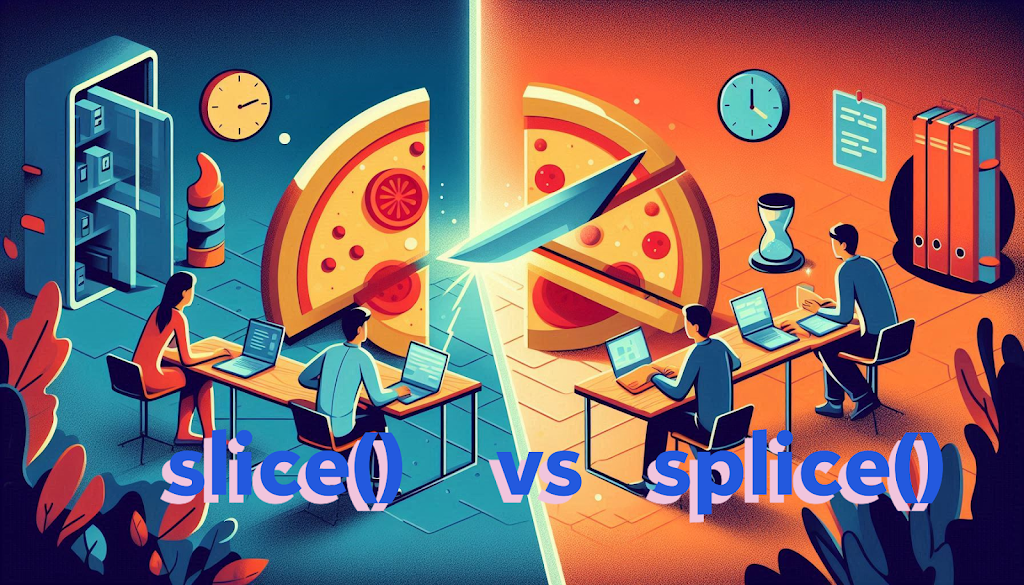When working with arrays in JavaScript, you’ll often come across two important methods: slice() and splice(). Though their names may sound similar, they serve different purposes. Understanding these differences is crucial for manipulating arrays effectively.
In this article, we’ll explore both methods, dive into their syntax, provide real-world examples, and explain when to use each one. By the end, you’ll have a clearer understanding of how and when to use slice() and splice() to manipulate arrays in your JavaScript projects.
Table of Contents
What is slice()?
The slice() method in JavaScript is used to extract a portion of an array without modifying the original array. It creates a new array containing the selected elements.
Key Features of slice()
- Does not alter the original array.
- Useful when you need a subset of an array.
- Returns a new array containing the sliced elements.
Syntax of slice()
array.slice(startIndex, endIndex);
- startIndex: The position in the array where the extraction begins (inclusive).
- endIndex: The position where the extraction ends (exclusive). If omitted,
slice()will take elements until the end of the array.
Example of slice() Usage:
const fruits = ['apple', 'banana', 'cherry', 'date'];
const slicedFruits = fruits.slice(1, 3);
console.log(slicedFruits); // Output: ['banana', 'cherry']
console.log(fruits); // Output: ['apple', 'banana', 'cherry', 'date']
- In this example,
slicedFruitsgets a subset of thefruitsarray, containing ‘banana’ and ‘cherry’, but the originalfruitsarray stays unchanged.
When to Use slice()?
Use slice() when:
- You want to create a copy or subset of an array.
- The original array must remain unchanged.
Real-World Example:
Imagine you have a list of students and you need to display only the top 3 scorers without modifying the original list:
const students = ['John', 'Alice', 'Bob', 'Eve', 'Charlie'];
const topStudents = students.slice(0, 3);
console.log(topStudents); // Output: ['John', 'Alice', 'Bob']
console.log(students); // Original list remains unchanged
What is splice()?
On the other hand, the splice() method allows you to modify an array directly. You can remove, add, or replace elements in an array. Unlike slice(), splice() changes the original array.
Key Features of splice()
- Modifies the original array.
- Can add, remove, or replace elements.
- Offers a more flexible approach to changing arrays.
Syntax of splice()
array.splice(startIndex, deleteCount, item1, item2, ...);
- startIndex: The index where the operation starts.
- deleteCount: The number of elements to remove (optional).
- item1, item2, …: Elements to add to the array (optional).
Example of splice() Usage:
1. Removing Elements:
const fruits = ['apple', 'banana', 'cherry', 'date'];
const removedFruits = fruits.splice(1, 2);
console.log(removedFruits); // Output: ['banana', 'cherry']
console.log(fruits); // Output: ['apple', 'date']
- In this example,
splice()removes two elements, starting from index 1. The originalfruitsarray is directly modified.
2. Adding Elements:
const fruits = ['apple', 'date'];
fruits.splice(1, 0, 'banana', 'cherry');
console.log(fruits); // Output: ['apple', 'banana', 'cherry', 'date']
- Here, we use
splice()to add ‘banana’ and ‘cherry’ at index 1, without removing any elements.
3. Replacing Elements:
const fruits = ['apple', 'banana', 'cherry', 'date'];
fruits.splice(1, 2, 'kiwi', 'grape');
console.log(fruits); // Output: ['apple', 'kiwi', 'grape', 'date']
splice()is used here to replace ‘banana’ and ‘cherry’ with ‘kiwi’ and ‘grape’, starting at index 1.
When to Use splice()?
Use splice() when:
- You need to modify the original array.
- You want to remove, add, or replace elements in the array.
Real-World Example:
Imagine you’re building a shopping cart for an e-commerce website. A user decides to remove an item from their cart:
const cart = ['Laptop', 'Mouse', 'Keyboard', 'Monitor'];
cart.splice(1, 1); // Removes 'Mouse'
console.log(cart); // Output: ['Laptop', 'Keyboard', 'Monitor']
In this example, the splice() method removes ‘Mouse’ from the cart, changing the original cart array.
slice() vs splice(): Key Differences
| Feature | slice() | splice() |
|---|---|---|
| Modifies Array | No (creates a new array) | Yes (modifies the original array) |
| Primary Use | Extract a portion of an array | Add, remove, or replace elements |
| Return Value | New array with selected elements | Array of removed elements |
Summary of Differences:
slice()is used to extract a portion of an array without modifying the original array.splice()is used to modify an array by removing, adding, or replacing elements directly.
At End
Both slice() and splice() are powerful methods for manipulating arrays in JavaScript. Understanding when and how to use each can help you write more efficient and effective code.
- Use
slice()when you need a subset of an array but want to preserve the original array. - Use
splice()when you need to alter the original array by adding, removing, or replacing elements.
By practicing these methods with real-world examples, you’ll be able to tackle a wide variety of array manipulation tasks in JavaScript. Whether you’re working on a web application or just learning JavaScript, knowing the differences between slice() and splice() will make you a better coder!
